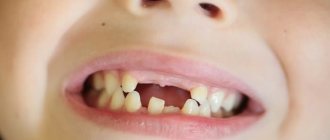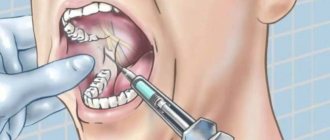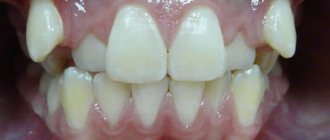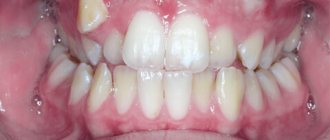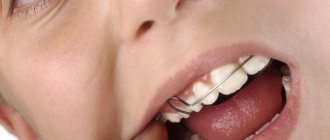The Infiltration Concept technology, abbreviated as Icon, quickly became widespread among the best dentists in the world. The innovation is that the use of a drill is no longer necessary.
German creators have made the use of special tools and solutions absolutely painless: a polymer solution is applied to the carious area, which hardens under the targeted influence of ultraviolet radiation, destroying bacteria that destroy the tooth. As a result, the caries area is sealed and the enamel density is restored.
Medicine is developing at a rapid pace, and this applies not only to surgery or cardiology, but also to dentistry. Every year, new and new means for dental treatment appear, as well as techniques that ensure the health of the dentition. Using the Icon technique, it is possible to cure caries without affecting the tooth structure with a drill.
The complete set for dental treatment with the Icon system is as follows:
- a set of tools, including interdental wedges, as well as syringes and attachments that allow you to work with all surfaces of the teeth;
- hydrochloric acid-based etching gel Icon-etch;
- Icon-Dry conditioner, used in conjunction with teeth drying;
- the infiltration material itself, on the properties of which the treatment method is based.
Enamel implantation without pain and drilling Innodent Repair
Methods for treating caries without drilling
Getting rid of caries without using a drill is the dream of every dental patient.
Not so long ago, it seemed absolutely unattainable. But technology is developing, new, more gentle, effective methods are constantly appearing. Today, treating caries without drilling is a completely common procedure. From a clinical point of view, caries is divided into 4 main stages of development. Gentle treatment methods, without the use of a drill, are used only in the initial stages of the disease, when the carious lesion has not penetrated deeper than the enamel. New technologies make it possible to stop the pathological process when a cavity has just begun to form in the fissure, without waiting for further destruction of dental tissue. Treatment of caries without a drill is carried out using the infiltration method, using ozone therapy, laser, and air abrasive effects.
Pros and cons of the Icon method
A couple of decades ago, it would have been impossible to imagine that new methods would appear in dentistry that would allow treatment without the use of a drill. Non-invasive methods of caries treatment are gaining popularity both throughout the world and in Russia. The demand for the Icon method is another confirmation of the fact that treatment without a drill is not only effective and pleasant for people, but also allows you to achieve the necessary results without further treatment.
However, as in any other area, there are those who have a rather detached attitude towards this technique, putting the existing small disadvantages at the forefront of their judgments. At the same time, some experts do not recommend the use of this technology even with slight damage to dentin.
Pros of using Icon:
- patient peace of mind, as there is no pain or discomfort;
- a solution for anyone suffering from dental fear;
- Only NuCalm technology can relieve fear better and more effectively - fast dental treatment with a guaranteed result;
- strengthening enamel and preserving tooth structure; for the treatment of initial caries, this is an effective and safe technique.
Cons of the Icon treatment:
- the technique is not suitable for medium and deep caries;
- secondary caries may occur (minimal risk, similar to conventional treatment methods);
- with absolutely the same condition of the teeth, treatment with traditional methods using a drill will be cheaper.
Often new forms and methods of treatment are perceived with caution and mistrust, and it takes more than a year for them to become firmly rooted in medical practice. But one cannot but agree that modern techniques allow one to avoid pain and discomfort from treatment with a drill. Icon technology deserves attention and trust.
Treatment of pericoronitis of the wisdom tooth in the lower jaw
Mistakes and complications in the treatment of dental pulpitis
Cervical caries on the front teeth: causes and treatment
Root canal treatment for chronic periodontitis
Dental treatment without a drill, placing a filling without drilling in Moscow
Treat or remove wisdom tooth pulpitis
Retreatment of tooth canals before prosthetics, with granuloma, cyst and aching pain
ICON or liquid filling
The infiltration method of treatment (ICON) consists of using a special light-composite polymer, which fills the pores of the enamel, sealing the affected area. The treatment mechanism is quite simple:
- The carious lesion is covered with a special gel that splits the surface enamel layer (enamel etching).
- After removing the gel, the tooth surface is dried, and a polymer material is applied to fill the porous structure of the enamel, blocking the path for the spread of bacteria that cause caries.
- The infiltrate is polymerized using a special lamp.
The ICON treatment method does not require mechanical action on dental tissue. The procedure is painless, lasts 10-15 minutes, and is used to eliminate superficial caries. Excellent for patients who are contraindicated for anesthesia - allergy sufferers, children, pregnant women.
Dental treatment for children under anesthesia
Local anesthesia
Treatment is usually carried out under local anesthesia, which comes in two types: application (without an injection) and infiltration (with an injection). The first option is used for superficial anesthesia and the danger is that the child may swallow a solution with a high concentration of lidocaine. Injection anesthesia is more reliable; it completely blocks pain in the receptor area.
Anesthesia
Some children are too restless and hyperactive, while others are afraid of dentists and refuse to open their mouths. How to treat teeth in this case? The problem is solved with the help of general anesthesia.
Do not be afraid of this method; it has long been used in Western countries to treat children from one year old. Some parents worry that anesthesia affects the child's memory or disrupts speech development. This is theoretically possible, but in practice this happens extremely rarely. But the cause of complications is not the anesthesia itself, but the child’s severe stress in dentistry or the presence of a chronic disease in combination with general anesthesia.
In the case of multiple bottle caries, anesthesia is the only way to carry out the necessary manipulations in one go. After all, it is unlikely that your child will be able to withstand 2 hours while the doctor fills all the teeth.
Tests before dental treatment in children under anesthesia
- general blood and urine analysis;
- biochemical blood tests;
- blood for sugar;
- electrocardiography.
You should not eat food 6 hours before anesthesia, and 4 hours before you should not take any liquid, including water. The child gradually falls into a state of sleep after several breaths of a gaseous sedative based on sevoflurane. You can wake up the baby at any time, you just need to increase the dose of oxygen. Within 15 minutes all reflexes return to normal.
Ozone treatment
The technique is based on the effect of ozone on the carious lesion. A special cap connected to ozone therapy equipment is put on the tooth. Exposure to ozone has a detrimental effect on pathogens. After disinfection, a special sealing agent is applied to the affected area. This method is used to treat caries in the spot stage, fissure, and molar surface caries. Ozone therapy is used for antiseptic treatment of carious cavities at any stage of the disease, as well as in the treatment of gingivitis, periodontitis and other periodontal pathologies.
METHOD 2: Eliminating caries without a drill using ozone therapy
Elimination of the carious process in the first stages, when the process has not yet developed to the point of a tooth enamel defect in the form of a cavity, but a non-pigmented carious spot has formed - this is possible with the help of an innovative device - the ozone generator Heal Ozone (KAVO) Germany. In this situation, it is possible to avoid drilling and traumatizing the enamel, and it is also possible to keep the tooth structure intact if it is necessary to eliminate the initial dental caries, the beginning process of “rotting” in the grooves of the tooth, and the carious process of the frontal parts of the teeth in the stage of demineralization.
Today this is a method recognized in the global dental community.
A special gaseous chemical substance, built on the basis of oxygen and having the ability to quickly disintegrate, is called ozone. Consisting of 3 oxygen molecules, this gas, when applied to it by physical factors that change the structure of the molecule (light wave, electric discharge), degrades into two chemical particles, one of which is a super active oxygen particle. The atomic oxygen molecule easily interacts with and reacts with any chemical. elements, turning them into oxides and changing their chemical properties. When interacting with substances that are part of the cell membrane of a pathogenic microorganism or virus, their death is caused. The highly active oxygen atoms released as a result of the reaction are destructive for pathogenic microorganisms. Consequently, during the action of ozone on the tooth, microorganisms that cause caries are destroyed.
The technique was first used by doctors from Germany and is highly effective.
Ozone is supplied to the demineralized area of the tooth through a specially designed nozzle. The procedure is not accompanied by sound, smell and is completely painless. Clearly measured portions of gas are supplied through the tube from the ozone generator. Negative pressure is created around the area of damaged enamel, as a result of which the nozzle of the device fits tightly to the tooth, creating a rarefied atmosphere. In 15-45 seconds, the active gas disinfects and sterilizes hard enamel tissue, killing pathogenic microorganisms that cause caries. To achieve a therapeutic effect, you should treat the tooth only once, and then carry out at least 1 procedure every six months. The ozone therapy procedure is followed by a special treatment of the tooth enamel: dentists apply a patented HealOzone liquid to the surface of the tooth, which causes mineralization (strengthening) of the tooth.
The liquid does not cause irritation to the soft tissues of the tooth and is safe for patients of any age. Patients are recommended to use the liquids from the HealOzone kit at home every day for 5 weeks, providing a long-term reliable supply of mineral components to strengthen tooth enamel.
- Removal of the carious process in the stage of white spot and surface demineralization of the tooth.
- Elimination of the carious process in a groove or blind fossa within the enamel at a stage when the cavity has not yet formed.
The ozone therapy procedure is indicated for use and gives maximum effect in cases where the dentist discovered tooth decay from the very beginning and it did not have time to form a cavity.
Laser technologies
Dental tissue preparation is performed non-contactly using a laser. The doctor adjusts the length of the laser beam according to the clinical picture. The radiation affects only the affected tissue, healthy tissue is not involved. Another advantage of the method is the absence of the vibration effect that occurs when the drill is operating. And this eliminates the risk of cracks and chips in the enamel. Laser radiation has a bactericidal effect; after treatment, the carious cavity is absolutely sterile; after filling, the development of secondary caries is excluded.
Treatment without a drill, using laser technologies, can be used both in the initial stages of caries and in cases of noticeable damage to the tooth, when it is necessary to place a filling. The procedure is painless, harmless, and is indicated for patients with special sensitivity, including children and pregnant women.
Complications and consequences of caries in children
Some parents believe that baby teeth do not need to be treated because they will soon fall out. It is not right! The formation of a normal bite depends on the condition of the primary teeth. If the carious infection progresses, it will penetrate into the deep tissues and damage the rudiments of the permanent dentition.
Premature removal of a baby tooth destroyed by caries also leads to disastrous consequences. Jaw growth is disrupted, new (permanent) teeth grow out of place, crowding and other problems appear. The child will have to wear braces.
In addition, advanced caries is complicated by pulpitis (inflammation of the dental nerve), periodontitis, or the formation of a cyst on the gum in the root area. It is very difficult to treat such consequences; it is necessary to fill the root canals.
In turn, periodontitis turns into osteomyelitis or an abscess, which not only reduces general immunity, but also threatens the child’s life!
Prevention of caries
Regular oral hygiene will help maintain dental health. You need to brush your teeth twice a day, using fluoride toothpastes and mouth rinses. Don't forget to use dental floss and irrigator. You can prevent tooth decay by limiting your carbohydrate intake. Sweets, baked goods, and carbonated drinks leave sticky residues that serve as a breeding ground for oral microflora. Bacterial plaque forms faster, which increases the risk of developing caries.
An important condition for caries prevention is visiting the dentist at least 2 times a year for examination and hygienic cleaning. Regular inspections allow you to detect problems at an early stage. In this case, it is possible to treat caries without drilling, using non-invasive technology.
Features of pediatric dentistry
Caries in baby teeth develops rapidly, so you need to visit the dentist at least once every six months, and preferably every three months. If the pathological process is started, pulpitis, periodontitis and other diseases may develop. If the pulp is damaged, treatment is delayed for three visits to the doctor. At the first stage, the dentist makes a diagnosis, opens the dental unit, places medicine inside, at the next stage, he removes the coronal pulp, and injects the medicine into the root part. Finally, a complete cleaning and filling is performed.
Pediatric dentists must have a thorough understanding of the psychology of children, as this is a complex group of patients. They often experience great fear, do not agree to procedures, and cannot sit still for a long time. If a child is scared and does not contact the doctor, then any procedure becomes a serious problem.
Maintaining the health of the dental system must be comprehensive. Young patients need to make an appointment not only with a therapist, but also with an orthodontist who deals with various developmental anomalies.
At what age can teeth be treated?
At what age do children have their teeth treated? This is a question that interests all parents of preschool children.
While the child is breastfed, such a need does not arise, especially since the first teeth begin to appear no earlier than 6 months from birth. But as soon as the child begins to eat at the common table and tries food familiar to the family, parents need to be attentive to the condition of the teeth. Problems with them begin when the body begins to lack minerals. The most dangerous period is from 5 to 14 years.
Therefore, as soon as the baby turns 1 year old, he needs to visit the dentist’s office every 6 months for preventive purposes. Caries or pulpitis of baby teeth detected at an early stage can be treated much easier and faster than advanced cases.
Modern approach
The psychological factor in the treatment of children plays an important role. In dental clinics, children's rooms are colorfully decorated, and doctors know how to find an approach to every child. Modern dental equipment produces quiet sounds that are not at all reminiscent of a familiar drill. While waiting, the child can play with his favorite toy or watch cartoons.
There are different ways to develop a child’s positive attitude towards visiting the dentist:
- The duration of the procedures is a maximum of half an hour;
- the drill is used minimally, taking frequent breaks;
- double anesthesia is performed (the injection is given after applying an anesthetic gel, ointment or spray).
If it is not possible to calm a small patient, the procedures are too painful or a large amount of work is expected, then treatment is carried out in sleep or under nitrous oxide. Up to three years of age, treatment is strictly under anesthesia.
